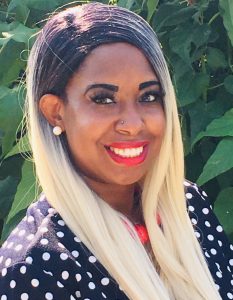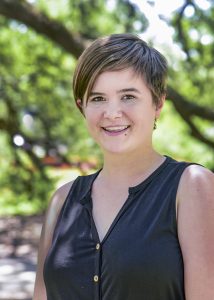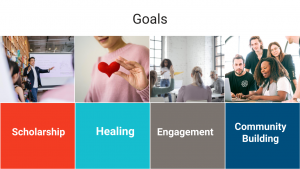Graduate students create a safe place for scholars to share lived realities
By Allison Brock

Student scholars from all over the country participated in the 2021 Communicating Diversity Student Conference.
Undergraduate and graduate students from Hawaii to Texas to Massachusetts presented work on collective healing, the theme for the 2021 Communicating Diversity Student Conference. The all-graduate-student run event is one of the annual COMM events where DEI commitment is put into action.
Emily Riewestahl, this year’s graduate student conference director, led the conference planning committee that consisted of nine members: Alaina Spiers, Angie Galal, Annie Ortiz-Martinez, Macy Dunklin, Mariana Rodriguez, Nour Zeid, Paige Jennings, Shelby Landmark and Tamanda Chabvuta. The committee worked throughout the spring semester to design, promote, and host the conference. Many graduate students and faculty from the COMM department supported the conference by serving as peer mentors and session chairs.
Hosted by the Climate and Inclusion Committee and sponsored by the Texas A&M University Department of Communication, Melbern G. Glasscock Center for Humanities Research, Department of Sociology, Women’s and Gender Studies program and Latino/a and Mexican American Studies program, the conference consisted of three morning sessions followed by a documentary screening led by Asha Winfield, concluding with four afternoon sessions and a keynote address from Amber Johnson, Ph.D. of Saint Louis University.
Dr. Leroy Dorsey, Associate Dean for Inclusive Excellence and Strategic Initiatives, chaired the keynote and awards reception. The keynote, which centered on healing justice and radical forgiveness, was inspiring and thought-provoking, said Srividya Ramasubramanian, a Presidential Impact Fellow and Professor of Communication.
Graduate students fight for the cause
When Riewestahl began planning the conference in early January, concern arose that faculty and students would not be able to participate as the continued threat of COVID-19 persists, said Hart Blanton, head of the COMM department.
“Way back in September when the department was reeling from everything COVID, I met with the chair of the Climate and Inclusion Committee and others in the Advisory Committee,” said Blanton. “We debated if it was feasible to plan for this event in the midst of a global crisis.”
Professor of Communication Joey Lopez said many faculty members shared their support for the conference because of their belief in the value of it.
“It almost didn’t happen and luckily it did,” said Lopez. “I have seen the impact this conference has on students, even when I was teaching at another university.”
Student scholars succeed
Riewestahl introduced and incorporated many engaging features at the conference that was held virtually for the first time since its founding in 2012 by Ramasubramanian.
The conference was navigable through the Whova platform which allowed the conference to feel as comfortable and accessible as an in-person conference would have felt, said Riewestahl.
“My goal was to make the conference engaging and allow for community building and networking, which is difficult to do on Zoom,” said Riewestahl. “I was looking for a platform that would create that feeling and space where attendees could meet and interact with each other.”
While designing the conference, Riewestahl said it was important to focus on four aspects: scholarship, healing, engagement and community building.
“We wanted to provide a space where students don’t have a ton of pressure, where they feel like their voices are heard and share any ideas that might be innovative in the field,” said Riewestahl. “I am so thankful to have a supportive community that cares deeply about diversity, inclusion and student support.”
The conference gave many student scholars the opportunity to present their work for the first time in a supportive and friendly environment, said Ramasubramanian.
“Bigger conferences with faculty co-panelists can be intimidating especially for first-generation students and historically marginalized groups,” said Ramasubramanian. “This conference gave students the confidence and validation that their diversity scholarship is valuable.”

Top paper award recipient Tyra presented her work “The stories that don’t make the news: An Autoethnography about navigating white newsrooms as a black female reporter.”
Recipient of the top paper award for graduate students Tyra Jackson shared “The stories that don’t make the news: An Autoethnography about navigating white newsrooms as a black female reporter” and said the environment gave her the platform to communicate her story for the first time.
“The conference was enlightening, not just in terms of research, but in terms of other people’s experiences,” said Jackson. “I listened to presenters from different universities share their experiences about everything from work and labor to COVID-19 to being a minority in America and how that affects their lives and academia.”
“It was cathartic in many ways.”
Students from all over shared their experiences in the workplace and academia which allowed many students to feel they were not alone in many of the struggles they are facing, said Jorge Garcia, the undergraduate recipient of the top paper award at the conference for his work “Opportunity; Academic Life as a Mexican Immigrant in Utah.”
“It was really exciting to hear different experiences and be able to connect with people in different ways,” said Garcia. “A lot of people have different experiences in their own lives, and it was interesting to see how those experiences are relatable.”
Ramasubramanian said the conference was founded by her with the goal that students from marginalized groups feel valued and heard, which continues to be the primary reason for the continuation of this conference.
“I hope these students feel very supported by this community,” said Ramasubramanian. “It is so valuable, what they’re doing.”
“They’re the future.”
Blanton said the vision brought forth by Riewestahl ultimately generated a successful and meaningful conference that captured the core values of the COMM department.
“The Communicating Diversity Student Conference is a statement of our values,” said Blanton. “Emily’s work this year helped us express our values at a challenging time.”


